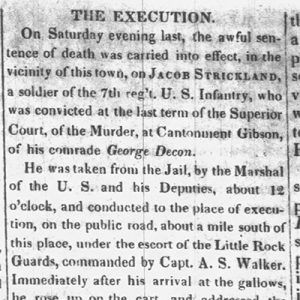calsfoundation@cals.org
Jacob Strickland (Execution of)
Jacob Strickland was a U.S. Army infantryman who was executed in 1828 for the murder of a fellow soldier in one of the earliest public judicial executions in the Arkansas Territory.
Jacob Strickland, a twenty-seven-year-old farmer from Philadelphia, Pennsylvania, enlisted in Company H of the Seventh U.S. Infantry Regiment on December 13, 1826; he was listed as five feet seven inches tall with hazel eyes, sandy hair, and a ruddy complexion. He proved not to be a very dedicated soldier, as he was reported as deserting from a base at Natchez, Mississippi, on March 22, 1827, being apprehended the next day. He apparently returned to service.
Private Strickland was serving with the Seventh at Cantonment Gibson in what is now Oklahoma when he murdered fellow private George Decon in early 1828; no details of the crime appear to exist. He was transported to the territorial capital in Little Rock (Pulaski County) and tried in April 1828. The Arkansas Gazette wrote that his guilt had been proven “by the voluntary confessions of the prisoner, during his confinement, accompanied with the strongest corroborating circumstantial testimony.” The jury deliberated for only a few minutes before returning a guilty verdict.
Judge Thomas P. Eskridge sentenced him in early May, stating that “yours was a premeditated and cold-blooded murder and all circumstances attending it, demonstrate a wicked, depraved and malignant spirit.” He ordered Strickland confined in the Pulaski County jail until May 31, after which he would “be hung by the neck, till you are dead—dead—dead.”
Strickland was taken from the jail at noon on May 31, 1828, and, escorted by the Little Rock Guards, taken about a mile south of Little Rock to be executed. The Gazette disgustedly wrote that the private was “under the influence of intoxication” as he made a rambling, hour-long statement, “taking two drinks of grog! by the way of refreshment.” The speech was made “in such an unconnected manner that but a very small portion of what he said could be understood.”
Finally, Strickland’s executioner placed a hood over his head, put a rope around his neck, and “the cart was driven from under him and the wretch was launched into eternity.”
For additional information:
“Conviction for Murder.” Arkansas Gazette, May 7, 1828, p. 3.
“The Execution.” Arkansas Gazette, June 4, 1828, p. 3.
“Trials for Murder.” Arkansas Gazette, April 30, 1828, p. 3.
Mark K. Christ
Central Arkansas Library System
 Law
Law Louisiana Purchase through Early Statehood, 1803 through 1860
Louisiana Purchase through Early Statehood, 1803 through 1860 Strickland Execution Story
Strickland Execution Story 



Comments
No comments on this entry yet.